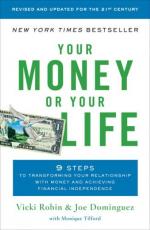
|
| Name: _________________________ | Period: ___________________ |
This test consists of 15 multiple choice questions and 5 short answer questions.
Multiple Choice Questions
1. How is net worth determined?
(a) All items purchased during a lifetime.
(b) Multiply monthly income by 12.
(c) Estimated current sale price of all items currently owned, plus other assets such as cash and investments.
(d) Add together everything owned, then subtract everything owed.
2. What does the physical perspective of money include?
(a) Gold.
(b) Personal responsibility and transformation.
(c) Using PIN numbers.
(d) Balancing a checkbook.
3. Which perspective of money should readers embrace?
(a) Hedges against inflation.
(b) Personal responsibility and transformation.
(c) Life energy.
(d) A personal perspective.
4. What are bare necessities, as defined in Chapter 1?
(a) A house and car.
(b) Food and water.
(c) Everything owned by an individual.
(d) All items needed to meet basic physical needs.
5. What three columns should record-keeping include?
(a) Gross income, life energy spent, and expenses to eliminate.
(b) Necessities, luxuries, and expenses to eliminate.
(c) Salary, gifts, and prizes.
(d) Income, expenditures, and hours of life energy spent.
6. What is an important aspect of the second half of Step 2?
(a) Tracking net worth.
(b) Saving as much money as possible.
(c) Not feeling shame or blame.
(d) Saving life energy.
7. What allows people to enjoy their planet, community, and spirituality more than ever before?
(a) Retirement.
(b) Living frugally.
(c) Being green.
(d) Taking more vacations.
8. According to many Americans, what is considered a sin?
(a) Working too much.
(b) Just sitting around and enjoying life.
(c) Spending too much.
(d) Buying low, selling high.
9. What should participants do if the answer to Question 2 is "no" for a particular item?
(a) Find a new career path.
(b) Find a new life purpose.
(c) Either change actions to align with values or change values to align with actions.
(d) Donate the item to charity.
10. Question 1 is answered with a plus sign under what circumstance?
(a) If the expenditure was worth the life energy spent.
(b) If the purchase was work-related.
(c) If the expenditure was a necessity.
(d) If income is greater than expenses for the month.
11. What is budgeting similar to?
(a) Dieting.
(b) Mathematics.
(c) Reducing income.
(d) Filing taxes.
12. What do people earn money by trading?
(a) Stocks and bonds.
(b) Excess possessions.
(c) Job skills.
(d) Life energy.
13. What determines mastery of Step 3?
(a) When life energy equals net worth.
(b) When income exceeds spending.
(c) When gross income has been determined.
(d) When the actual money left at the end of the month equals the amount shown by recordkeeping.
14. What are comforts, as defined in Chapter 1?
(a) Pillows and mattresses.
(b) Things people really enjoy.
(c) Emotional support.
(d) Employment and financial security.
15. What is the term for the unnecessary things, activities, and noise in our lives?
(a) Comforts.
(b) Luxuries.
(c) Clutter.
(d) Security.
Short Answer Questions
1. Earning, saving, and spending money are part of which perspective?
2. What must a person do to become financially independent?
3. Each person has only a limited amount of what?
4. How often should people total their income and expenses?
5. What causes emptiness?
|
This section contains 514 words (approx. 2 pages at 300 words per page) |

|




